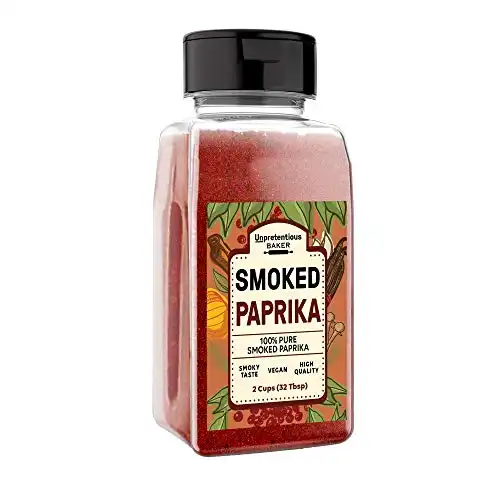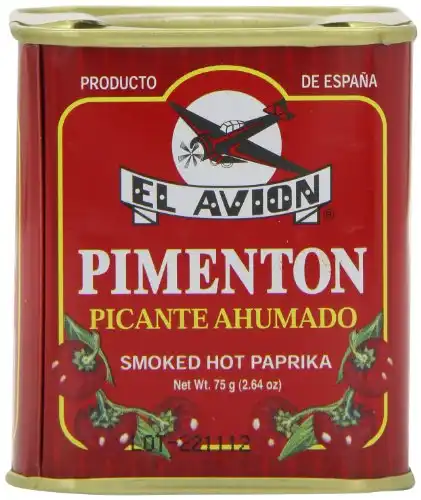Smoked Paprika Guide

A staple of traditional Spanish cuisine, smoked paprika is becoming increasingly popular for BBQ marinades and rubs, or to simply spice up any dish that calls for a depth of flavor without too much heat.
If you’re new to smoked paprika, you may have a lot of questions. Where does it come from? What does it taste like and how should I use it?
In this guide, we aim to answer all of these questions and more. Read on to find out all you need to know about this versatile and delicious spice.
What is smoked paprika?
Smoked paprika is a deep red spice made from dried chili peppers, which are smoked, typically over oak or beech wood, before being dried and ground to a fine powder. It is a central element of most traditional Spanish recipes, where it is still made today.
You will find both hot and sweet smoked paprika. Usually, the main difference is that the hot version is made with the chili seeds included, whereas the sweet smoked version has them removed before the grinding takes place.
Thanks to its Spanish heritage and long history of use, smoked paprika has several different alternative names. The main ones are:
- Pimenton
- Pimenton de la Vera
- Picante pimentón
- Spanish paprika
How spicy is smoked paprika?
Smoked paprika has a complex, rich, and smoky flavor, whether it’s sweet or hot. If you’re wondering how hot smoked paprika is, here’s its average ratings on the Scoville scale:
- Sweet smoked paprika: 100-250 SHU
- Hot smoked paprika: 500-1,000 SHU
The Scoville scale is used to measure the heat of peppers. It ranges from 100 SHU or less for bell peppers, up to just over three million SHU for the hottest rated pepper, known as Pepper X.
As you can see, even the hot version of smoked paprika is not rated as pungent. It is much milder than cayenne pepper, for example, which generally averages around 30,000-50,000 SHU.

Common uses
Smoked paprika is fast gaining popularity in America. Aside from being a typical, traditional accompaniment to deviled eggs, you’ll find that it goes well in almost any dish that a hint of smokiness and mild heat would improve.
With its Spanish roots, you will find smoked paprika a must for most traditional Spanish dishes, including:
We think smoked paprika is such a versatile spice. It’s great for livening up your BBQs, chowders and egg recipes. Try out a sprinkling with some of the following:
- Pork dishes
- Beef stews
- Chicken dishes
- Potato sides
- Soft baked cheese
- Omelets
- Scrambled eggs.
Is your mouth watering yet? Check out our smoked chicken rub recipes for more inspiration.
Smoked paprika vs regular paprika
If you’ve never tried smoked paprika before, you’re probably wondering just how it differs from regular paprika.

Smoked paprika is made from ground smoked and dried peppers, whereas regular paprika is made from ground dried peppers only. This makes a huge difference when it comes down to taste and gives smoked paprika its rich smoky flavor.
Smoked paprika is, therefore, very different from regular paprika when it comes to taste.
While you could try using regular paprika in a recipe that asks for the smoked version, recipes that require regular paprika might be overpowered by the depth of flavor that comes from a hint of smoked paprika.
Our advice? Save the smoked version for hearty, flavorsome recipes that can take on the rich flavor of smoked paprika.
Use it in meat marinades or dry rubs for BBQs or add a little to stews where it can really bring your tastebuds to life.
It can also be used as recommended to bring a burst of flavor to more bland recipes such as egg dishes or white meat.
How to use smoked paprika
Smoked paprika is an easy-to-use, highly versatile spice, so you shouldn’t have any issues using it.
Here are our recommendations on how to best use smoked paprika:
- If you’re using it for the first time and without a recipe, go easy and slowly increase levels until you reach a taste that works for you. Remember, you can always put more in, but you can’t take it back out.
- Be careful when heating paprika, it can burn pretty easily. Cook it with a little olive oil over a low heat to prevent it from sticking and blackening.
- Be sure to store your smoked paprika in an airtight container and to use it within approximately 12 months. As it’s only available in ground form, look for batches with long “best before” dates.
How to make your own smoked paprika
It’s possible to make your own smoked paprika. It’s fairly time-consuming and involves a little messing around, but, if you enjoy the sense of achievement that comes with all things homemade, then why not try it out?
- Ideally, you should start out by growing a paprika pepper variety, such as Alma paprika peppers. However, you can experiment and use whatever peppers you have to hand for now.
- Once ready, you’ll need to smoke them over oak wood for around 15 days. You could also use an electric smoker to make things a little easier. Be sure to turn the peppers once a day, and if you’re using an electric smoker, you should turn it off overnight.
- Once your peppers are smoked, you will need to ensure that they are thoroughly dried out before grinding them into fine smoked paprika powder. Traditionally this would be done under the hot Spanish sun, but if the climate at home isn’t suitable, you could use your oven on a low heat or even a dehydrator. In any case, you will need to ensure your smoked peppers are bone dry, without the slightest trace of humidity.
- Once you’re satisfied that your peppers are thoroughly dry, grind up the smoked peppers for hot smoked paprika powder, or remove the seeds first for sweet smoked paprika.
- If you have a large batch of smoked peppers, you should only grind what you’ll need for the next few weeks. Store the rest in airtight containers and grind them up when needed to restock your supplies.
Smoked paprika substitutes
Forgot to stock up on smoked paprika at the store? Or maybe you’re trying out a new recipe and you need a good alternative to smoked paprika?
While it’s fairly difficult to replicate its rich, smoky taste, there are several substitutes to smoked paprika that you could try.
Take a look at our suggestions listed below and see which ones you have available and whether they fit your tastes and recipe.
- If you have regular paprika but your recipe calls for smoked paprika, add a touch of cumin for a subtle smokiness.
- If you have no paprika at all, then you could try using a combination of cumin with a touch of chili powder, although this will be hotter and missing that unmistakable depth of flavor you get with paprika.
- Liquid smoke can be a good replacement for smoked paprika. You’ll certainly get the smokiness; however, bear in mind that you won’t get the bright red color – which can be a bit of a let down for pale-colored egg and potato recipes in particular.
- For those of you who like it hot, try chipotle pepper powder. A word of warning, this is a lot hotter as it is made from dried, smoked jalapenos. It’s certainly similar, making it a good replacement – but, you’ll want to use a lot less to avoid creating an inedible dish.
- If you have none of the above and you aren’t averse to a bit of heat, then cayenne pepper makes an acceptable stand-in. Although it is much hotter and lacks the smokiness, it is easily found in many stores and home spice racks.
Where to buy
Smoked paprika is readily available.
You should be able to find it in most stores with good spice sections. There is also a huge selection of smoked paprika available to purchase online, including specialty versions that are made in Spain using traditional artisan methods.
Wrapping it up
It’s clear to see why smoked paprika is one of our favorite spices.
Versatile yet distinctive, warming but not overly hot – its rich, complex and smoky flavor brings out the very best of numerous dishes.
What do you think? Have you used smoked paprika in your recipes? Let us know in the comments below and don’t forget to share this guide with your foodie friends!









